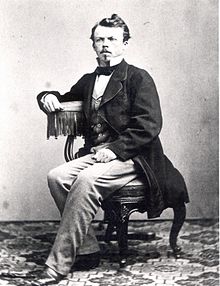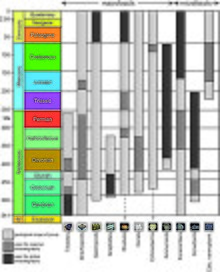114:
258:
224:, are biozones which are defined by being a specific segment of an evolutionary lineage. For example, a zone can be bounded by the highest occurrence of the ancestor of a particular of a taxon and the lowest occurrence of its descendant, or between the lowest occurrence of a taxon and the lowest occurrence of its descendant. Lineage zones are different from most other biozones because they need that the segments its bounded by are successive segments of an evolutionary lineage. This makes them similar to
249:, is a biozone that is defined by the range in which the abundance of a particular taxon is highest. Because an abundance zone requires a statistically high proportion of a particular taxon, the only way to define them is to trace the abundance of the taxon through time. As local environmental factors influence abundance, this can be an unreliable way of defining a biozone. Abundance zones are named after the taxon that is the most abundant within its range.
28:
236:
An assemblage zone is a biozone defined by three or more different taxa, which may or may not be related. The boundaries of an assemblage zone are defined by the typical, specified fossil assemblage's occurrence: this can include the appearance, but also the disappearance of certain taxa. Assemblage
73:
it contains. These may be a single taxon or combinations of taxa if the taxa are relatively abundant, or variations in features related to the distribution of fossils. The same strata may be zoned differently depending on the diagnostic criteria or fossil group chosen, so there may be several,
199:
A concurrent-range zone uses the overlapping range of two taxa, with low boundary defined by the appearance of one taxon and high boundary defined by the disappearance of the other taxon. Concurrent-range zones are named after both of the taxa in it.
191:) occurrence of a single taxon. The boundaries are defined by the lowest and highest stratigraphic occurrence of that particular taxon. Taxon-range zones are named after the taxon in it.
308:
As only a small portion of fossils are preserved, a biozone does not represent the true range of that species in time. Moreover, ranges can be influenced by the
228:- however, lineage zones, being a biozone, are restricted by the actual spatial range of fossils. Lineage zones are named for the specific taxon they represent.
128:, who characterized rock strata by the species of the fossilized animals found in them, which he called zone fossils. Oppel's biozonation was mainly based on
31:
Biozone types. Each rectangle represents bodies of sedimentary rocks and each line a different taxon. The arrows indicate the taxon first or last appearance.
615:
Hatley, Tom; Kappelman, John (December 1980). "Bears, pigs, and Plio-Pleistocene hominids: A case for the exploitation of belowground food resources".
167:
Range zones are biozones defined by the geographic and stratigraphic range of occurrence of a taxon (or taxa). There are two types of range zones:
398:"Biochronology and biochron boundaries: A real dilemma or a false problem? An example based on the Pleistocene large mammalian faunas from Italy"
156:
517:
212:
is a biozone with the upper boundary being the appearance of one taxon, and the lower boundary the appearance of another taxon.
664:
Signor, Philip W.; Lipps, Jere H. (1982), "Sampling bias, gradual extinction patterns and catastrophes in the fossil record",
293:
are also good candidates because they tend to be present even in very small samples and evolve relatively rapidly. Fossils of
550:
Betts, Holly C.; Puttick, Mark N.; Clark, James W.; Williams, Tom A.; Donoghue, Philip C. J.; Pisani, Davide (October 2018).
381:
525:
312:, meaning that the last "disappearance" of a species tends to be observed further back in time than was actually the case.
208:
An interval zone is defined as the body of strata between two bio-horizons, which are arbitrarily chosen. For example, a
74:
sometimes overlapping, biostratigraphic units in the same interval. Like lithostratigraphic units, biozones must have a
500:
467:
82:. These stratotypes are named according to the typical taxon (or taxa) that are found in that particular biozone.
17:
681:
277:
are some of the most useful as zone fossils, as they preserve well and often have relatively short biozones.
97:
in which the grouped biozones usually have a related characteristic. A succession of biozones is called
650:
701:
309:
552:"Integrated genomic and fossil evidence illuminates life's early evolution and eukaryote origin"
706:
529:
563:
144:
8:
136:
135:
he found throughout Europe, which he used to classify the period into 33 zones (now 60).
567:
592:
551:
341:
225:
677:
632:
597:
579:
496:
473:
463:
397:
377:
336:
278:
237:
zones are named for the most characteristic or diagnostic fossils in its assemblage.
59:
48:
257:
669:
624:
587:
571:
113:
282:
36:
122:
575:
695:
636:
583:
477:
427:
321:
601:
346:
286:
125:
75:
70:
270:
673:
509:
101:. The length of time represented by a biostratigraphic zone is called a
628:
290:
79:
515:
331:
301:
can be used for biozonation of
Quaternary rocks as they were used by
274:
132:
63:
269:
A great variety of species can be used in establishing biozonation.
27:
326:
302:
298:
262:
129:
121:
The concept of a biozone was first established by the 19th century
102:
462:. Harper, D. A. T. Chichester, West Sussex, UK: Wiley-Blackwell.
85:
The boundary of two distinct biostratigraphic units is called a
175:
A taxon-range zone is simply the biozone defined by the first (
52:
55:
294:
457:
549:
51:
that are defined on the basis of their characteristic
93:, and multiple biozones can be grouped together in a
252:
668:, Geological Society of America, pp. 291–296,
460:Introduction to paleobiology and the fossil record
693:
516:Holtz, Thomas R. Jr; Merck, John W. Jr. (2006).
614:
143:, in which he established comparisons between
666:Geological Society of America Special Papers
651:"Cannabis In Archaeology & Palaeobotany"
663:
139:would further reinforce the concept in his
430:. International Commission on Stratigraphy
89:. Biozones can be further subdivided into
69:A biostratigraphic unit is defined by the
591:
159:defines the following types of biozones:
141:Prodrome de Paléontologie Stratigraphique
518:"GEOL 331 Lectures 6-7: Biostratigraphy"
490:
256:
194:
157:International Commission on Stratigraphy
112:
26:
371:
14:
694:
422:
420:
418:
261:Commonly used zone fossils (from the
522:GEOL 331: Principles of Paleontology
453:
451:
449:
447:
445:
376:(Second ed.). Wiley-Blackwell.
367:
365:
363:
361:
170:
66:properties of the surrounding rock.
458:Benton, M. J. (Michael J.) (2009).
231:
150:
24:
415:
240:
25:
718:
495:. Geological Society of America.
493:International Stratigraphic Guide
442:
358:
253:Zone fossils used for biozonation
203:
215:
657:
643:
608:
556:Nature Ecology & Evolution
543:
484:
390:
374:Sedimentology and stratigraphy
220:A lineage zone, also called a
162:
13:
1:
352:
372:Nichols, Gary (2009-06-10).
7:
315:
226:chronostratigraphical units
147:and their biostratigraphy.
10:
723:
108:
576:10.1038/s41559-018-0644-x
428:"Biostratigraphic Units"
62:which is defined by the
491:Salvador, Amos (2013).
210:highest-occurrence zone
60:lithostratigraphic unit
526:University of Maryland
266:
245:An abundance zone, or
222:consecutive range zone
177:first appearance datum
118:
41:biostratigraphic units
32:
260:
195:Concurrent-range zone
185:last appearance datum
116:
30:
674:10.1130/spe190-p291
568:2018NatEE...2.1556B
310:Signor-Lipps effect
629:10.1007/bf01561000
342:Chronostratigraphy
267:
119:
58:, as opposed to a
33:
562:(10): 1556–1562.
383:978-1-4051-3592-4
337:Lithostratigraphy
171:Taxon-range zones
145:geological stages
49:geological strata
47:are intervals of
16:(Redirected from
714:
687:
686:
661:
655:
654:
647:
641:
640:
612:
606:
605:
595:
547:
541:
540:
538:
537:
528:. Archived from
513:
507:
506:
488:
482:
481:
455:
440:
439:
437:
435:
424:
413:
412:
410:
408:
394:
388:
387:
369:
232:Assemblage zones
151:Types of biozone
137:Alcide d'Orbigny
78:designated as a
21:
722:
721:
717:
716:
715:
713:
712:
711:
702:Biostratigraphy
692:
691:
690:
684:
662:
658:
649:
648:
644:
613:
609:
548:
544:
535:
533:
514:
510:
503:
489:
485:
470:
456:
443:
433:
431:
426:
425:
416:
406:
404:
396:
395:
391:
384:
370:
359:
355:
318:
283:dinoflagellates
255:
243:
241:Abundance zones
234:
218:
206:
197:
173:
165:
153:
111:
37:biostratigraphy
23:
22:
18:Assemblage zone
15:
12:
11:
5:
720:
710:
709:
704:
689:
688:
682:
656:
642:
623:(4): 371–387.
607:
542:
508:
501:
483:
468:
441:
414:
389:
382:
356:
354:
351:
350:
349:
344:
339:
334:
329:
324:
317:
314:
287:foraminiferans
254:
251:
242:
239:
233:
230:
217:
214:
205:
204:Interval zones
202:
196:
193:
172:
169:
164:
161:
152:
149:
123:paleontologist
110:
107:
9:
6:
4:
3:
2:
719:
708:
705:
703:
700:
699:
697:
685:
679:
675:
671:
667:
660:
652:
646:
638:
634:
630:
626:
622:
618:
617:Human Ecology
611:
603:
599:
594:
589:
585:
581:
577:
573:
569:
565:
561:
557:
553:
546:
532:on 2007-06-20
531:
527:
523:
519:
512:
504:
502:9780813759388
498:
494:
487:
479:
475:
471:
469:9781405186469
465:
461:
454:
452:
450:
448:
446:
429:
423:
421:
419:
403:
399:
393:
385:
379:
375:
368:
366:
364:
362:
357:
348:
345:
343:
340:
338:
335:
333:
330:
328:
325:
323:
322:Biochronology
320:
319:
313:
311:
306:
304:
300:
296:
292:
288:
284:
280:
276:
272:
264:
259:
250:
248:
238:
229:
227:
223:
216:Lineage zones
213:
211:
201:
192:
190:
186:
182:
178:
168:
160:
158:
148:
146:
142:
138:
134:
131:
127:
124:
115:
106:
104:
100:
96:
92:
88:
83:
81:
77:
72:
67:
65:
61:
57:
54:
50:
46:
42:
38:
29:
19:
707:Paleontology
665:
659:
645:
620:
616:
610:
559:
555:
545:
534:. Retrieved
530:the original
521:
511:
492:
486:
459:
432:. Retrieved
405:. Retrieved
402:ResearchGate
401:
392:
373:
347:Index fossil
307:
291:plant pollen
279:Microfossils
268:
246:
244:
235:
221:
219:
209:
207:
198:
188:
184:
183:) and last (
180:
176:
174:
166:
154:
140:
126:Albert Oppel
120:
117:Albert Oppel
98:
95:superbiozone
94:
90:
86:
84:
76:type section
71:zone fossils
68:
64:lithological
44:
40:
34:
271:Graptolites
163:Range zones
99:biozonation
91:subbiozones
696:Categories
683:0813721903
536:2008-04-16
353:References
281:, such as
87:biohorizon
80:stratotype
637:0300-7839
584:2397-334X
478:213775572
332:Acme zone
275:ammonites
265:onwards).
247:acme zone
133:ammonites
602:30127539
327:Teilzone
316:See also
303:hominids
299:cannabis
263:Cambrian
130:Jurassic
103:biochron
45:biozones
593:6152910
564:Bibcode
407:May 10,
109:History
680:
635:
600:
590:
582:
499:
476:
466:
434:11 May
380:
53:fossil
289:, or
678:ISBN
633:ISSN
598:PMID
580:ISSN
497:ISBN
474:OCLC
464:ISBN
436:2018
409:2017
378:ISBN
297:and
295:pigs
273:and
155:The
56:taxa
670:doi
625:doi
588:PMC
572:doi
189:LAD
187:or
181:FAD
179:or
43:or
35:In
698::
676:,
631:.
619:.
596:.
586:.
578:.
570:.
558:.
554:.
524:.
520:.
472:.
444:^
417:^
400:.
360:^
305:.
285:,
105:.
39:,
672::
653:.
639:.
627::
621:8
604:.
574::
566::
560:2
539:.
505:.
480:.
438:.
411:.
386:.
20:)
Text is available under the Creative Commons Attribution-ShareAlike License. Additional terms may apply.


